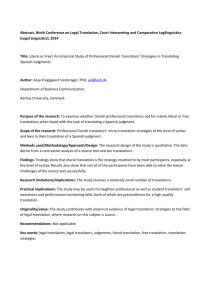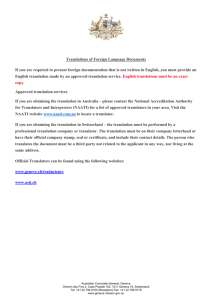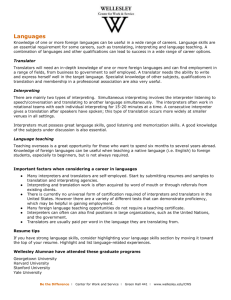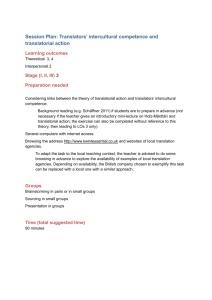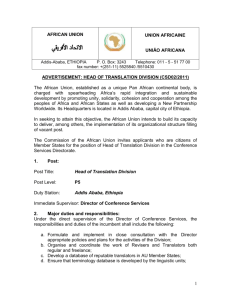1 Status This article was published in Lebende Sprachen. Zeitschrift
advertisement
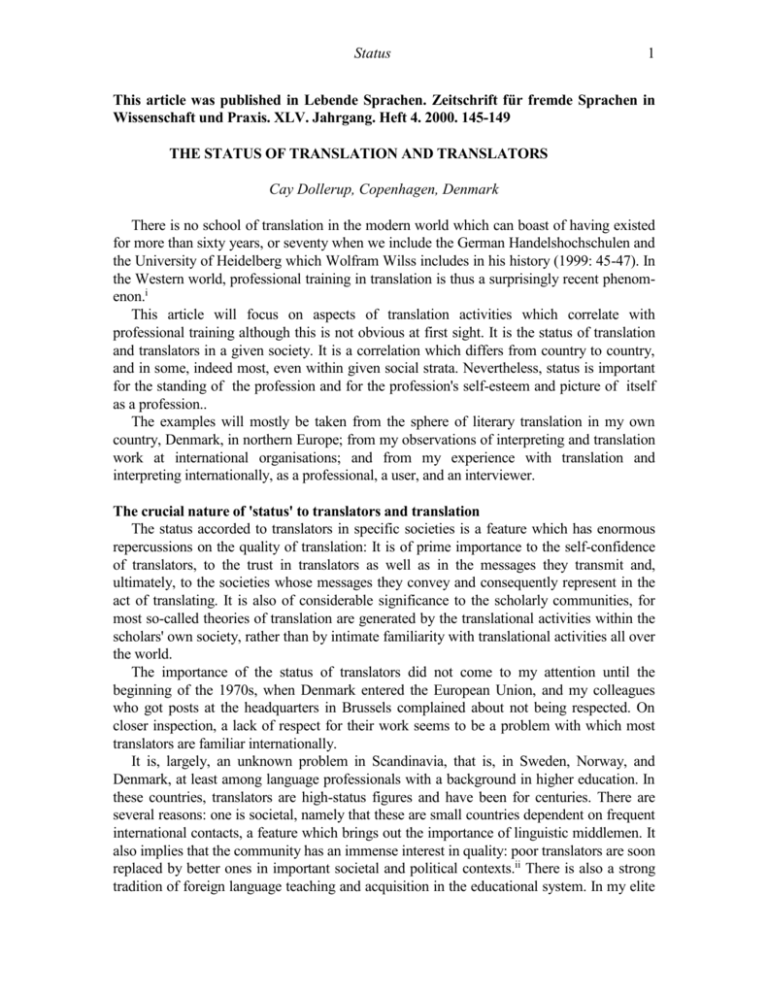
Status 1 This article was published in Lebende Sprachen. Zeitschrift für fremde Sprachen in Wissenschaft und Praxis. XLV. Jahrgang. Heft 4. 2000. 145-149 THE STATUS OF TRANSLATION AND TRANSLATORS Cay Dollerup, Copenhagen, Denmark There is no school of translation in the modern world which can boast of having existed for more than sixty years, or seventy when we include the German Handelshochschulen and the University of Heidelberg which Wolfram Wilss includes in his history (1999: 45-47). In the Western world, professional training in translation is thus a surprisingly recent phenomenon.i This article will focus on aspects of translation activities which correlate with professional training although this is not obvious at first sight. It is the status of translation and translators in a given society. It is a correlation which differs from country to country, and in some, indeed most, even within given social strata. Nevertheless, status is important for the standing of the profession and for the profession's self-esteem and picture of itself as a profession.. The examples will mostly be taken from the sphere of literary translation in my own country, Denmark, in northern Europe; from my observations of interpreting and translation work at international organisations; and from my experience with translation and interpreting internationally, as a professional, a user, and an interviewer. The crucial nature of 'status' to translators and translation The status accorded to translators in specific societies is a feature which has enormous repercussions on the quality of translation: It is of prime importance to the self-confidence of translators, to the trust in translators as well as in the messages they transmit and, ultimately, to the societies whose messages they convey and consequently represent in the act of translating. It is also of considerable significance to the scholarly communities, for most so-called theories of translation are generated by the translational activities within the scholars' own society, rather than by intimate familiarity with translational activities all over the world. The importance of the status of translators did not come to my attention until the beginning of the 1970s, when Denmark entered the European Union, and my colleagues who got posts at the headquarters in Brussels complained about not being respected. On closer inspection, a lack of respect for their work seems to be a problem with which most translators are familiar internationally. It is, largely, an unknown problem in Scandinavia, that is, in Sweden, Norway, and Denmark, at least among language professionals with a background in higher education. In these countries, translators are high-status figures and have been for centuries. There are several reasons: one is societal, namely that these are small countries dependent on frequent international contacts, a feature which brings out the importance of linguistic middlemen. It also implies that the community has an immense interest in quality: poor translators are soon replaced by better ones in important societal and political contexts.ii There is also a strong tradition of foreign language teaching and acquisition in the educational system. In my elite Status 2 school, for instance, English was taken up in the sixth grade, German in the seventh, Latin in the eighth, and French in the ninth grade. All language teaching included translation in the form of language drills. University training took in translation exercises - albeit at a primitive level. It was infinitely more important that students would have to prepare for orals where - among other things - they had to translate Old English, Middle English, and modern English texts orally from books at exams: In other words, we were trained in on sight translation. As educated people, we, of course, would meet immediate social needs: uneducated people and the older generation would not know English, let alone Spanish. On many occasions, we would have to function in ways which we now describe in precise terms as liaison interpreting and consecutive interpreting in negotiations and lectures. At that time, in the late 1950s, language teachers at univer- // … 146 // sity were trained to be employed at Danish secondary schools, the 'gymnasia' (Obere Hochstufe) found in Copenhagen and in a few major provincial towns. But these teachers had another role which went unheeded and unmentioned, but which was nevertheless highly pertinent, namely that they could serve as linguistic middlemen for visiting foreign luminaries in the local community. This added to the high status which they already had as academics. Conversely, legally valid documents, business contracts, translations for business and industry were handled by public translators who were trained at a private school and whose translations of public documents would be (and still are) legally binding in Denmark. Formal training, text types, and status You will note that - then as now - there is no formal training of translators for many types of texts, such as literature, technical and scientific texts.iii In principle, the Danish market looks as follows. There are: - formal training graduate programmes at the business schools of future translators of business and legal texts, - courses offered in subtitling, often leading to employment with subtitling companies (mostly at university), and - an otherwise open field. In fact, the courts use public translators for the major languages; most businesses use graduates from the (two) national business schools; Danish interpreters at the European Union are increasingly from the business schools and trained at a special course.iv All of these people are well-paid and have a high social status. In so far as they are graduates, subtitlers and literary translators tend to have a university background. Free-lancers have different backgrounds. In the budding trade of liaison interpreting most performers working for the authorities have received intensive training at short courses. They tend to be from immigrant groups and clearly have status in their communities. Conversely, many autodidact translators with all-Danish backgrounds feel that they are not really respected. Most professionals with degrees have no such problems. But salaries tend to be the same. Remuneration for translation of 'cultural texts', of which literary texts are a subgroup, is lower than for legal and technical texts. Good literary translators, however, are in high demand and often receive more than 50 per cent above the negotiated standard fee. Their prestige is high and book reviews often contain comments on the quality of the translation. Unlike their counterparts in most other countries, Danish translators are entitled to make changes in translations if books are reissued and they continue to receive money from Status 3 libraries as long as the translated books are available for public loan (per page). There are changes, and mostly, I believe for the better: ten years ago, it was rare for a newspaper to cite the name of the translator of an article taken from a foreign newspaper, now the name of the translator is regularly cited. The translators' status and the longevity of their translations It is hard to assess the importance of the translators' status on the prestige (and sales) of the product because this is often a trade secret. But we may turn to the past, primarily to the literary field, in which translators are well-known and have social visibility. Let us have a look at two classics. The first is Ms Charlotta Dorothea Biehl's translation of the Spanish classic Don Quixote (1605-1615). The Danish translation appeared in 1776-1777. Ms Biehl was one of the first Danish woman authors. She knew many languages, received a public stipend for her work and wrote some original Danish drama. However, today she is primarily remembered for this translation "the deliberate archaic style of which causes an effect not found in any later translation." (Gyldendals Litteraturleksikon. My translation) With slight modernisations following changes in Danish orthography, her translation reigned supreme until 1998: It had a life-span of 221 years. In this case, then, we see how a highly respected woman author endows a translation with authority and status, and, in turn, she is eventually remembered best for her translation. The Tales of Jacob and Wilhelm Grimm were first published in 1812-1815 in Berlin. They were soon translated into other languages, first into Danish and Dutch and then into English. In The Sin-Complex (1996), Martin Sutton discusses the English translations of the Tales. Although Sutton misses this point, it is eminently obvious that the early British translators often had a scant command of German. The situation in Denmark was the opposite (Dollerup 1999). Partly because, until 1864, one third of Denmark (SchleswigHolstein) was German-speaking, partly because the German tales were considered common Pan-Germanic cultural heritage, the Danish translators of the tales were prominent figures in society. Here is a list of the life-spans of reasonably long-lived collections of Grimm tales in Denmark: LIFE-SPAN OF TRANSLATIONS (COLLECTIONS) Edition/translator Period Number of years Molbech's Selected Fairytales Oehlenschläger Carl Ewald 'Lindencrone' Daugaard Molbech's Reader Anine Rud Grete Janus Hertz Søren Christensen 1843-1943 1816-1909 1905-1992 1823-1909 1894-1964 1832-1860 1966-1998 1968-1998 1968-1998 100 93 87 86 70 37 32 30 30 Status Markussen Davidsen Bondesen Morsing 4 1900-1929 1854-1882 1897-1922 1946-1968 29 28 25 22 Let us concentrate on the status of the top people: Christian Molbech was a professor at the University of Copenhagen (a very high status in Danish societyv), Adam Oehlenschläger the foremost Danish poet of the Romantic period, Carl Ewald a well-known and popular author, and Johan Frederik Lindencrone a member of the aristocracy; these translators represented the upper crust of Danish academics, intellectuals and nobility. The correlation between the translator's status in society and the popularity of the translation is fairly clear in this case. Sutton's study of the English scene reflects a totally different market situation: in the United Kingdom, translations were commissioned from anonymous translators whose German was poor and whose status was low. Status and legal rights This last feature brings into focus the question of the translators' legal rights. Much ballyhoo in Translation Studies is due to the fact that translation scholars are ignorant of, or just do not pay heed to, differences in translators' rights which also connect with the status of translators: In today's world, the produce of commissioned or in-house translators is part of the common property of the institution for which they work. This goes from the European Union and the United Nations, via multinationals such as IBM, to humble firms exporting papayas. Commissioned and in- // … 147 // house translators are invisible to the outside world and their individuality is blurred by corporate image, editing, rewriting, by being used in ads, recipes and the like. Most translation scholars seem to be unaware that in most countries even literary translators do not have special rights over their products. In the English-speaking world, most translators are paid a lump sum for a literary translation and their product is subject to in-house editing. A few translators may enjoy the privilege of being allowed to discuss editorial work with house editors, but most are not given a chance.vi There is a certain lack of respect for translation work in this system, and the disregard for or lack of legal rights for translators means both that their status is low and also, that their impact on the work ascribed to them may be less than scholars assume. In other words, language professionals often have little significance according to such central values in the Western world as 'originality', 'copyright', or just 'influence'. This clearly ties in with a view of translation as a mechanical transfer of words from the source to the target language - and which many translators actually unwittingly instill in their audience by indiscriminate discussions of 'word-for-word' translation and 'equivalence' as central issues in translation. At all events, translation is not a highly esteemed trade in some countries. The Belgian José Lambert (1996) uses this figure: Status 5 Lambert comments: "[The] conclusions have been confirmed by many tests ... So our conclusions ... may well be representative of the average treatment of verbal communication in ... international business communication. ... Our analyses make us conclude that management itself is imperilled, and this applies to political, cultural, military as well as economic management." (Lambert: 286-287) He suggests an alternative, adding: "When business societies include language in their general planning they increase flexibility, they can anticipate problems and they are even able to use language not only in negative terms, that is, as an obstacle, but also as a strategic tool." (290) It requires a close inspection indeed to realise that these phrases are pertinent to a specific social and political context, namely Belgium, which has a divisive two-language policy and in which language workers have a low status. It is dangerous for the Belgian nation that the powers that be hold cross-cultural and interlingual communication in low esteem. But, in itself, this state of affairs cannot be generalised into an observation which applies world-wide. The conclusion to be drawn from the last example is also that there is a correlation between national unity and the heed central governments should pay to language services, including national ones catering for linguistic minorities. The status of language workers in international organisations At this stage it is appropriate to look at the language services of the European Union, the eleven official languages of which make it the largest language organisation in the world.vii The language services are divided into translation and interpreting. Belonging to the 'academics', interpreters and translators are among the best paid staff. We might therefore assume that working conditions are good. But a close look reveals that they are not: the translators are not visible and have relatively poor contacts with their users; although, on the one hand, they have glossaries and the 'Eurodicatom' terminology list at their disposal, they were, until recently lagging behind the private market in terms of machine-aided translation. In this case, then, the externals of the system are in place, but the professional tools are frequently not up to standard; working conditions are imposed rather than deriving from the needs of the nature of the actual work.viii The interpreting services have excellent booths; at the beginning of many sessions, chairs go to great lengths to explain to delegates how to handle interpreting (because of the time lag and the use of 'relay'). But there are startling differences in the language workers' status in the European Union according to what countries they work for: Danish delegates seem to be the only ones to talk amicably with their interpreters (and to inform them what languages they should not interpret from). Conversely, I have attended a meeting where a southern European delegation was furious with their interpreters who could not render a culturally anchored concept adequately. In both types of transfer, it seems as though we meet with some kind of acceptance of Status 6 status by the decision makers who dish out salaries and provide the physical framework. But the status of actual (junior) language workers does not seem to be sufficiently high for their representatives to be accorded a say in policy decisions concerning working conditions: There are, undoubtedly, translators and interpreters who have become decision makers, but they usually turn out to have been administrators who have lost touch with daily work. At the United Nations the language professionals are highly salaried, too. I have not checked the translation services, but, in 1992, I did get into the interpreting booths of the Security Council. These booths were small. The interpreters had to put napkins into the ventilation shafts to avoid the heavy draft. So at our most august international organisation, the status of the linguistic middlemen may, in principle, be high with the employing staff, but they are not treated as if this were the case by the actual users: they are just wordmachines. Who are these translators, anyway? We have not got a clear picture from this analysis. Part of the explanation is that, as in most discussion of translation work, the focus has been on elitist translation work: the translations of literary classics in European literature and in so far as we did not discuss literature, on language workers who mediate at some of the highest levels in the world. So I have focused on high-class, educated translators, whereas there are clearly also other factors at work. A return to the Danish scene, now less hampered by my own academic background, is in place:9 The liaison interpreters fall into a number of categories. Those employed by some of the 'charity organisations' turn out to be paid very poorly by the hour (something like double the minimum salary), even when they have some official training; they have discussion groups but are not organised. The court interpreters are selected by the authorities and are organised in an association, which, however, has no right to negotiate remuneration, only to pass on information. On the other hand, the pay is reasonably decent. The liaison interpreters for doctors and others are indistinct and without real rights. In immigrant families, many a young boy or girl acts as the intermediary for elderly family members. For all their rights, even literary translators turn out to have differences - in addition to the one already mentioned // … 148 // in terms of higher payment to respected translators: royalties for children's books used to be lower than those for adult literature (according to an agreement from 1947). Although this has changed so that there is no longer any difference, authors and translators of children's books receive lower annual royalties from libraries than authors of books for adults - but in this case, there is a rational explanation, namely that, to the outside observer, there are usually fewer words per page in children's books than in books for adults (but please don't rub it in with translators of children's books). Surprise, surprise: although I would have believed that all Scandinavia was the same it turns out that in Norway, 1,000 copies of good children's books are automatically distributed by the state; in Sweden the 'same' state is concerned about contents of children's literature and insists that children's books should be educational; it is only in welfare Denmark that publishers may publish books with naughty protagonists - and then keep their fingers crossed, hoping that the libraries (the main purchasers) buy the books, for as a commodity, children's literature does not sell all that well. The subtitling market has also undergone a change. The amount in Dkk - or Euros - paid Status 7 for a subtitled film on the prime Danish channels has not gone up since 1974 (it is still c. 8,000 Dkr), but in real buying power it does represent something like a reduction to one third. A prominent subtitler also stressed that there is no longer all that prestige to the job. Understandably so, when one notices that in 1974 when I first checked television subtitling there was only one channel, whereas now there are at least ten: the quality of the subtitling on the narrowest channels clearly depends on the composition of the (presumed) target audience: on provincial or highly commercialised channels it is abysmal, whereas the narrow elitist public service channel still upholds a reasonably good quality. This brings up the question of users of the translations. Their expectations, or lack of expectations, clearly affect the product. Siemens will not accept a lousy translation of their products into any language, and consequently their in-house translators will be paid well just like the interpreters and translators of the European Union. In other cases, firms in industry throw up their hands and leave renditions to native speakers who are free to 'localise' as much as they believe is needed: the firms and organisations cope by demanding that their translators are trained, have diplomas and, above all, have been checked by professionals. Translation Theory Academics tend to refer to theory as the be-all and end-all of everything. It will have been noticed that this article has started out with the belief on my part that translation was a highly esteemed activity, and I looked down my nose at those who had problems with maintaining their status. Examples of eminent translations were adduced, which, in retrospect and on the background of a larger canvas reveal that individual status, either in the literary or even in the societal establishment was of prime importance. We noticed how status is given to mediators by the powers that be in international organisations, but let us then ponder whether this is to ensure communication of their own eminent messages in foreign tongues or whether it is in order to promote the status of their interpreters and translators. And, finally, we swept back at the initial comments. It is obvious that we are all prone to fall victim to easy generalisation, including about translation. I believe that the overview serves to show why some translation theories originate in some cultures rather than others, and that we do not have to be very sophisticated, but can fall back on pure prejudice: Eugene Nida and other biblical translators focused on 'equivalence' because in between cultures and languages, the sacred message must remain the same. Those who, like Whorf, argued that languages are formed by cultures conducted (semi-)anthropological studies. Hans Vermeer's 'Skopos'-Theorie in which the translator bends the message to make it fit the target culture is eminently suited to a nation like Germany whose interest lies in exporting industrial produce. On the other hand, descriptive translation studies as espoused by Gideon Toury and José Lambert stand for the views of small nations. Let me add that I am closest to the last-mentioned school - but then I do come from a small nation. It is tempting to conclude that scholars in small countries are more sensitive to what translation does and consequently are more prone to describe it. It does indeed seem that we all make our theories from our immediate surroundings. But let us avoid turning them into universals. Status 8 The future and the translator Some of my readers are probably still convinced that human translators are language machines and that the sooner they are replaced with the faster, cheaper and more instantaneous translations now available on the internet, the better. Internet translations are here to stay - no doubt about it. The question is: what do they mean to translation. As I see it, they will, first of all, increase the amount of translated material prodigiously. Potentially every home page posted can be translated into some kind of language from which you can distill the gist of the message. But in order to make coherence, in order to establish texts which constitute completely understandable messages, new skills will be called for, primarily that of critical overview in tomorrow's translators. Perhaps the creative skills of the human translators will be the most important human contribution to many translations. But the century which saw the internet translation at its close has brought into the field of translation numerous new types of linguistic middlemen: translators translating synchronised films, subtitlers working for the cinema and television in many countries, simultaneous interpreting. So there is no reasonable doubt that there will come new types of transfer that we cannot even dream of in the coming century. In terms of trade, in terms of the professionals' legitimate attempts to improve their remuneration and their status, the past and the present century have not been static at all. On the contrary, just like the act of translation, the professionals in the trade and the whole field of translation is intensely dynamic and ever-changing. Concluding remarks The picture is blurred for translators' status is a complex entity, which may, indeed, be impossible to discuss internationally because it may be so culture-specific that comparisons are misleading. First, it is clear that we cannot generalise from one country to another: there is an immense difference between Lambert's Belgium (1996) where the language workers are largely ignored and my Denmark where at least one third of all literature is translated from other languages, subtitling on television found in eighty per cent of the entertainment programmes, and Greenlandic accepted as the main language in nearly autonomous Greenland. Yet, when even that homogeneous country is subjected to an in-depth analysis, differences galore appear. Secondly, it is equally obvious that there are differences in status according to the roles played by the middlemen (and depending on the clients): the international conference interpreter ranks high above the liaison interpreter in an interview with a social worker. There are also differences in status according to the medium for which the translator works, but // … 149 // these are probably so different from country to country that it is meaningless to set up any kind of hierarchy: how would we rank a Swedish subtitler, a German translator of film scripts for synchronisation purposes, and a South African translator who translates the dialogue of a television serial so that, instead of being shown as subtitles or heard as dubbing, it is broadcast on the radio while the television is on. Thirdly, training programmes are important for enhancing the status of translators - and hopefully will also improve the standard of translators: there are very few these days who dare say that interpreters and translators are 'born'. Training programmes are also important Status 9 to clients and to the societies in which translators work. Fourthly, it is also important that there are organisations for the advancement of the profession, be it by the establishment of discussion fora, or, for that matter, trade unions with the right to collective negotiations. In this respect, the Scandinavian countries are probably unique, since it is not only business translators but even literary translators who have collective agreements with employers. Subtitlers have only informal get-togethers, while court interpreters have some organisation. And other mediators again have never bothered to think in such terms. Fifthly, the relationship between employers and language workers must also be taken into account. It is a murky area since there must be much variation, but one point stands out: the professionals seem to have surprisingly little say on their primary working conditions. Similarly, the relationship between the linguistic middlemen and their immediate users is also crucial. It appears reasonable to assume that the more the users know about foreign language command, the higher their respect for the linguistic middlemen, and consequently, the higher the status the latter are accorded. This would fit in nicely with the above comments on international organisations: Policy makers appreciate the need of linguistic services and provide the obvious externals, good salaries and high placements in the hierarchy, but they are incapable of immediately identifying the daily needs. And, finally, there is the status which some people can bring to translation work, because they are already well-known in other fields. It is legitimate for us to promote the status of language professionals. There are potential cul-de-sacs, especially in many discussions in Translation Studies which generalise from one specific translational situation or from one national context and argue that it applies globally. The road is thorny and long - and more thorny in some countries than in others. In order for translators to attain status, there must be good Translation Studies programmes. These programmes must stress quality in any product in any media and accept that even 'quality' is a dynamic entity. These institutions must also be aware that they benefit from the propagation of consciousness of what constitutes quality in translation, also among non-professionals. They must also be prepared for innovation, indeed radical changes in the curricula to meet the changing needs of a changing world. They should cooperate with associations which further the interests of the profession. They should support publications which promote translation work. And they should teach their students to be independent and stand up for their views and rights, in order that they are prepared to do so, even when they are not 'established' but only junior staff. I am not unrealistic in my expectations of how far the individual can go, but, as mentioned at the beginning, there is a correlation between high status and high quality in translation work. The more conscious translators, interpreters, and teachers are of this, and the more they can convince clients that this is the case, the better the prospects for the improvement of the profession in terms of both the quality of the product and its status in society. That status is important for translators in modern Western societies which are permeated by translation from top to bottom: at the latter, because democratisation allows minorities to speak out - and quite often in their own language; at the top level is the glue which ensures continued international co-operation.10 Footnotes Status 10 1. There were some type of translator training in China in the11th century BC and around AD 983 (see Hung: 31-32). 2. The first state-employed translator in Denmark got his post in 1635. The authorisation of public translators was introduced in 1782, nearly coinciding with industrialisation as well as the French revolutionary and Napoleonic wars. These two latter events, I suggest, constituted the first important wave of internationalisation and led to the establishment of large-scale professional translation (of educational, technical, and scientific texts) in 19th century Europe. 3. Denmark (population c. 5.2 million) is to a large extent a bilingual society and certain domains, such as pop music and advanced technology will be more English than Danish. By international standards, young Danes perform well in English. The Danish job market for translators and interpreters is approximately as follows in terms of people who actually make a living from language work: Literary translators (including non-elitist literature) c. 50, subtitlers c. 150, interpreters c. 100, independent translators c. 200; in-house translators c. 5,000. Literary translators often do non-literary work and many interpreters in Denmark do translation as a sideline (and vice versa). The Danish Writers' Guild negotiates for literary translators, and the the Danish Association of Business School Language Graduates, which boasts of 10,000 members (from the business schools). Many of these either work full-time in English or perform more than language work, so they are not full-time translators. 4. The six-month course is funded by institutions of the European Union and caters for postgraduates. Similar courses are found in other European Union member states. In the 1970s most interpreters would be university graduates but by now the business school graduates predominate. I assume that this is because the 'text types' dealt with in conference interpreting have become increasingly specialised and because delegates are collectively trained in deciphering the 'close translation' of conference interpreting. 5. A Danish professors' salary will be in the 10% highest income bracket nationally and the status corresponds to being head of a firm with 50-100 employees. 6. Although translators and publishers who use in-house editing are open about it, in-house editing of translation is rarely dealt with by scholars. I know only of Bush (1997) and Klaudy's discussions (1996). They refer to, respectively, the UK and Hungary. 7. For an in-depth description of language work at the institutions of the European Union, see Dollerup 1996. Please note that illustrations 3 and 4 have been switched. 8. Recently, interpreters were provided with laptops. But there was a significant time lag, compared to private industry. Personally, I am in no doubt that my description of a certain lag will still hold good in twenty years' time. Let us hope that I am wrong. 9. Much of the following information about the Danish (and Scandinavian) scene derives from Allan Hilton Andersen, Nanna Gyldenkærne, Gösta Jönsson, Ingerlise Koefoed, and Torben Weinreich, 10. An earlier version of this article was read as a paper of the 'GSTI 30th Anniversary Conference', Monterey, California, January 1999, and subsequently posted on the internet as a conference paper. Works cited Bush, Peter. 1997. Strawberry Flowers in the Realm of Chocolate: The Training of Literary Translators. In: Labrum, Marian (Ed). 1997. The Changing Scene in World Languages. ii............ Status 11 Amsterdam and Binghamton: John Benjamins. 109-117. Dollerup, Cay. Language work at the European Union. In: Rose, Marilyn Gaddis (Ed). 1996. Translation Horizons Beyond the Boundaries of Translation Spectrum. Binghamton: Center for Research in Translation. 297-314. Dollerup, Cay & Vibeke Appel (Eds). 1996. Teaching Translation and Interpreting . Proceedings of the third 'Language International' conference. Amsterdam: John Benjamins. Dollerup, Cay. 1999. Tales and Translation. A study of the translations of the Tales of the brothers Grimm from Pan-Germanic heritage to shared international fairytales. Amsterdam: John Benjamins. Gyldendals Litteraturleksikon I-IV. 1974. Harmer, Henning & Thomas Jørgensen (Eds). Copenhagen: Gyldendal. Hung, Eva. 1996. Translation curricula development in Chinese communities. In: Dollerup & Appel (Eds). 1996. 31-44. Klaudy, Kinga. 1996. Quality assessment in school vs professional translation. In: Dollerup & Appel (Eds). 1996. 197-204. Sutton, Martin. 1996. The Sin-Complex. A Critical Study of English Versions of the Grimms' Kinder- und Hausmärchen in the Nineteenth Century. Kassel: Brüder Grimm-Gesellschaft. Wilss, Wolfram. 1999. Translation and interpreting in the 20th century: Focus on Germany. Amsterdam & Philadelphia: John Benjamins. i............ ii............ iii............ iv............ v............ vi............ vii............


